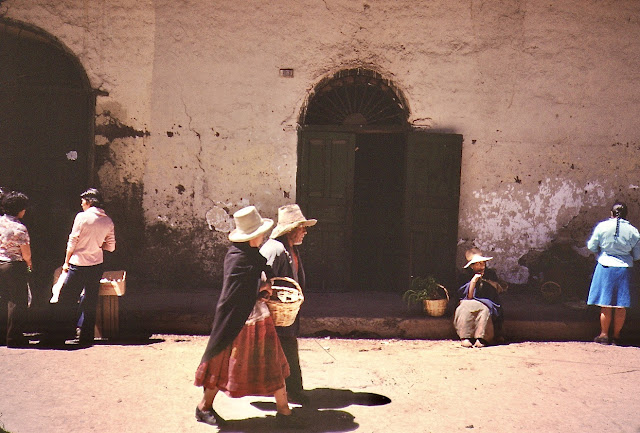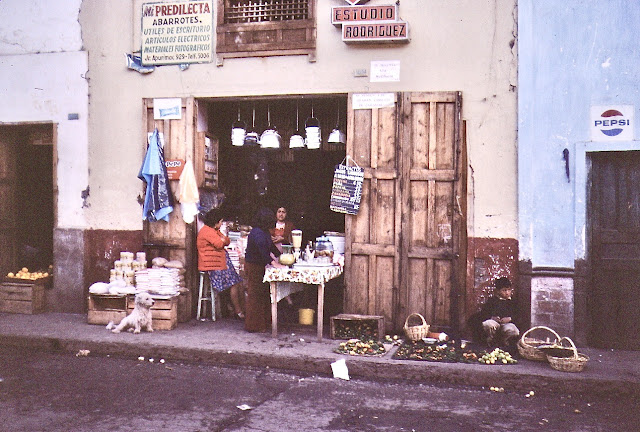Cajamarca, Peru April 23-26
Even when we entered the verdant green valley, almost jungle-like in its proliferation of vegetation, the mountains on either side remained the same – great rock giants, very dry, very silent.
Only after four or five hours, after we had penetrated well into the Andean range, and climbed a little higher, did the landscape become uniformly green, including the mountain sides. And then so green, and so beautiful! Here also with a massiveness and ruggedness of character that I don’t recall seeing in Ecuador. The scale seems somehow grander… and the wildflowers! Everywhere, everywhere. Of brilliant colours. Many yellows and reds, but lots of blues, pinks, purples, whites and oranges too. They take their colours from the sky, where every day a rainbow can be seen – tonight a very broad and very faint one, glowing in the orange light of the sunset… My favourite wildflower is a yellow five-pointed beauty, a little larger than the rest, that seemed to be welcoming us, waving its hands, ‘hello! Hello!’ A sun-star, star-sun flower.
And then we really began to climb. And climb. Weaving our way through tunnels of red-red earth, emerging into open cliff-side vistas of mountain-sides and, far far below, river valleys, almost all cultivated, until we got so high that we were in the clouds – and the cold – and couldn’t see anything but the tall trees which lined either side of the road. Night fell slowly, beautifully, between the heavy fog and mist – patches of pinks and purples appearing and disappearing as the clouds parted temporarily, and then closed in again – and we descended into the evening lights of Cajamarca. There we received a reception somewhat reminiscent of the one at San Augustine – small boys asking if we wanted a hotel, if we wanted to go see the ruins, if we wanted… But the town is not as touristy as San Augustin, despite the fact that it’s larger. There’s a very tranquillo air about it – ‘una buena honda’.. No one’s in a hurry, no one’s putting on the buy-buy-buy pressure.
One of the most wonderful things about Cajamarca, and a trademark of the area,
is the floppy woven grass hats worn by men and women alike.
Cajamarca is fairly high in the sierra – over 3000 meters – so high enough to be ‘fresco’, wonderfully so, in the mornings and evenings, and low enough to be pretty hot during the days when the sun is shining, which is most days. We’re doing a lot of hiking in the surrounding countryside, enjoying the century plant fences and groves of eucalyptus trees – what a heavenly scent – I’ve collected some of the ‘cones’ and keep them in my pack with my clothes, just for the scent!
The spikey, serrated edges of the century plant, and their massive
size, make them a good barrier to marauding animals - and humans.
The market here is small and has a very local atmosphere. Definitely not a tourist market. Families of indios and meztizos camped on the sidewalks, their goods arranged in neat little piles infront of them, or perhaps with a wooden stand or stall in the long line of stalls that flank either side of the various market streets. In the afternoon it was quiet, most of the men in the bars drinking, chewing coca, prattling on with their friends. Groups of women and children, knitting, picking lice from out of each other’s scalps, spinning, always spinning, the wool from one stick to another, rearranging their wares in more neat little piles, or just gazing off into the distance, all along the sidewalk.
Little boy, on right, with his piles of vegetables to sell. Just outside the market area.
Impressions of Peru so far: here the landscape, the people, the life, seems more ‘American’ than in Ecuador. Wider streets, less Spanish-looking houses, more ‘American’ in organization. There are more – and larger – American cars, jeeps and trucks here. In many ways it seems like a ‘richer’ country. The Latinos here dress in a more American, less European style – lots of jeans – and carry themselves in a more American way.
But despite some signs of wealth, the poverty here seems more abject, especially among the indigenous peoples. Their houses seem cruder, and poorer, though it may be more a difference in architecture and organization. Many of the Indios are so thin, so thin, it’s hard to believe they can still support themselves, even stand, let alone walk. Yet they are physically larger – taller with larger frames, than the Indios in Ecuador. Their facial features less refined, almost Slavic in appearance, and their complexions are a little lighter than the Indios in Ecuador. Interestingly their eyes tend to be more almond-shaped, more Asian looking. I wonder about connections between the indigenous cultures of the world… .
Like the Latinos, the Indios tend to dress in more European clothes – bright coloured polyesters. Many are dressed in real rags, completely tattered, patched and repatched, knees and elbows sticking out here, there and everywhere. Their hats are of woven straw or cane, very large, with huge, generally up-turned brims. All of the Indios wear a hat: the kids look like walking toadstools – all you can see is hat and legs. The little girls are just as colourful, in their polyester blouses of hot pink and orange, their heavy wool skirts of blue and red, and their shawls and sashes of every colour of the rainbow, as their mamas. And their smiles are just as endearing. When they smile, which is often, their entire face lights up.
Best of all the food here is much better than in Ecuador. Much more variety and quality. More and better meat, dairy products (there’s yogurt practically everywhere), bread, cheese, honey, lots of fruit, vegetables, salads, and all sorts of good ‘dulces’, especially a kind of milk pudding, almost like tapioca, which is sold everywhere.
Today I spent half the day trying to finish a colour pencil drawing I started yesterday of an old, weathering agave leaf – colours such as I have never seen before, and of course could never duplicate – and the other half wandering, again, through the market, buying a bit of fruit and some vegs for tomorrow’s bus ride to Trujillo.
As I wander amidst all this today for some reason I feel my essential transience, and my insignificance, more acutely. Not only because I am a ‘traveler’, a transient by definition, but also because of the transient nature of my life-style, and my culture. We live in such a fast-paced culture, a culture where change is not just accepted and embraced, but heralded, celebrated. Most of Indians here are living now as they have lived, more or less, for hundreds of years. There is something very stolid, almost immutable, in their mien, their aspect, their attitudes that seems to say ‘no’ to change, to deny its very existence. Like the mountains around them, these people seem almost impervious to change.
Perhaps as a result of the ambience here I can feel myself slowing down, becoming more in sync with the energy around me. I am losing track of time – minutes, hours, even days pass by without notice – there is nowhere I need to be and nothing I have to do. I am floating, like a piece of flotsam, being carried by whatever tides and currents pull or push me – up, down, sideways, onwards, backwards. It doesn’t seem to matter. I am again doing several hours of yoga during the day, taking advantage of the all day sun to warm, loosen and relax my muscles. It feels so good. I am regaining – perhaps more properly I should say ‘finding’ or ‘refinding’ – a sense of peace. Or as they say here ‘tranquilidad’ – es muy tranquillo aqi, muy tranquillo....




















Comments
Post a Comment